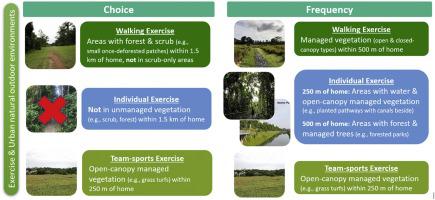Urban Forestry & Urban Greening ( IF 6.0 ) Pub Date : 2020-12-19 , DOI: 10.1016/j.ufug.2020.126947 Claudia L.Y. Tan , Chia-Chen Chang , Le T.P. Nghiem , Yuchen Zhang , Rachel R.Y. Oh , Danielle F. Shanahan , Brenda B. Lin , Kevin J. Gaston , Richard A. Fuller , L. Roman Carrasco

|
Growing recognition of nature’s benefits to many aspects of human wellbeing has prompted the incorporation of both urban green and blue natural outdoor environments (NOEs) into cities. Amongst the many purposes of NOEs, promotion of physical exercise has been garnering interest, given the increasingly sedentary lifestyles of urban dwellers. However, studies rarely consider how different types of NOEs, let alone the combination of them, might affect the type and frequency of physical exercise conducted by urban residents. We use Singapore, a highly urbanised tropical nation with a considerable number of NOEs, as a case-study to address these gaps. We used a market research survey (n = 1519), geographic information systems, and generalised linear regression models to investigate the relationship between residential NOE cover, exercise-influencing sociodemographic factors, and outdoor exercise choice (i.e., if respondents exercised or not) and frequency of four types of physical exercises: walking, individual-based, team-sports, and overall exercise. For exercise choice, more people walked in areas with higher forest and scrub cover, and less in areas with just scrub. Less conducted individual-based exercise in areas with high unmanaged vegetation cover, and more conducted team-sports in areas with higher open-canopy managed vegetation cover. Amongst those who engaged in these exercises, managed vegetation cover is positively correlated with walking (open- and closed-canopy combined) and team-sports (open-canopy) frequency. Individual-based exercise frequency rose in areas with a mix of high open-canopy managed vegetation and blue space cover within 250 m from one’s home, and a mix of high managed treescape and forest cover 500 m from one’s home. Findings suggest that a specific mix of NOEs can promote the participation of different types of physical exercise. Integrating the right NOE types and combinations into urban residential spaces may thus help to mitigate sedentary lifestyles, boosting public health outcomes in city populations.
中文翻译:

正确的组合:在热带城市国家,住宅城市的绿色-蓝色空间组合与体育锻炼相关
人们越来越认识到自然对人类福祉的益处,这促使将城市绿色和蓝色自然户外环境(NOE)纳入城市。在NOE的许多目的中,由于城市居民久坐的生活方式越来越多,促进体育锻炼引起了人们的兴趣。但是,研究很少考虑不同类型的NOE,更不用说它们的组合如何影响城市居民进行体育锻炼的类型和频率。我们使用新加坡这个高度城市化的热带国家,拥有大量的NOE作为案例研究来解决这些差距。我们使用了一项市场研究调查(n = 1519),地理信息系统和广义线性回归模型来研究住宅NOE覆盖率之间的关系,影响运动的社会人口统计学因素,户外运动的选择(即是否进行了受访者的运动)以及四种体育锻炼的频率:步行,个人健身,团队运动和整体体育锻炼。为了进行运动选择,更多的人走在森林和灌木丛较高的地区,而走在只有灌木丛的地区的人较少。在植被覆盖度不高的地区进行的基于个体的锻炼较少,而在开放式林冠覆盖度较高的地区进行的团队运动较多。在从事这些运动的人中,管理的植被覆盖度与步行(开放式和封闭式顶篷组合)和团队运动(开放式顶篷)频率呈正相关。在个人离家不超过250 m的高盖林管理的植被和蓝色空间覆盖的区域,以及离家500 m处高管理的树景和森林覆盖的区域,基于个人的运动频率增加。研究结果表明,特定的NOE组合可以促进不同类型的体育锻炼的参与。因此,将正确的NOE类型及其组合整合到城市居住空间中可能有助于减轻久坐的生活方式,从而提高城市人口的公共卫生成果。











































 京公网安备 11010802027423号
京公网安备 11010802027423号